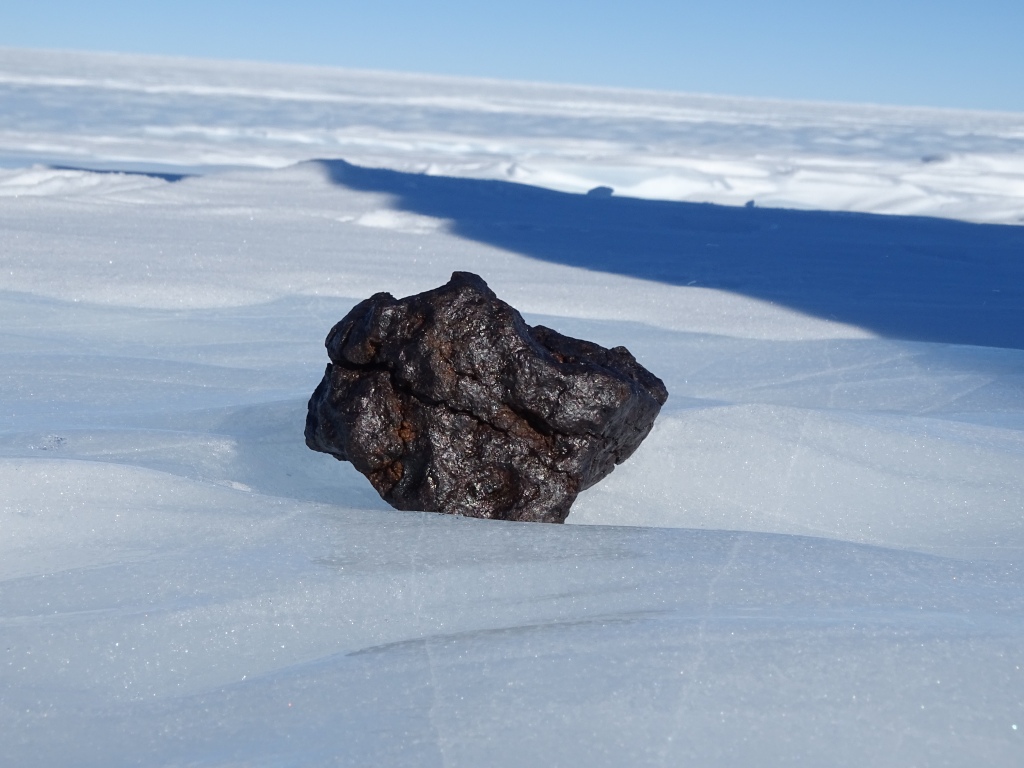Classification: Mesosiderite.
Explainer: This means that the sample is from a differentiated asteroid parent body. Mesosiderites are quite an unusual type of meteorite – it is a stony-iron, meaning that it is made up of roughly equal parts silicate minerals and iron metal. As of may 2021 there are only 280 meteorites that have been classified as being a mesosiderite, with only 61 of the group having been found in Antarctica. In terms of the Lost Meteorite of Antarctica project goals finding this sample is very interesting – as it is a stony-iron type of meteorite would would have perhaps expected to find meteorites like this sitting below the ice, rather than on the top ice surface. We are looking into this question as we classify more of the samples we found!
Description: Taken from the Meteoritical Bulletin for OUT 18014
History: The meteorite was recovered as part of the Lost Meteorites of Antarctica project, which was funded in the UK by the Leverhulme Trust and supported by the British Antarctic Survey and the University of Manchester. These samples were collected as part of the project’s first field season in austral summer December 2018 – January 2019 by a two person field party consisting of Katherine Joy and Julie Baum. Found on blue ice surface at Outer Recovery Icefields ice field 3 (west icefield). Altitude 1410 m. Second stone (233.46 g) found close by on blue ice surface apx 5 metres away.
Physical characteristics: Total mass 760.83 g. Pieces: 2. Main mass 527.30 g, dimensions: 12 cm x 10 cm x 8 cm, an irregular, part stone with no fusion crust and dark grey exterior. Orange rust visible. Second stone, 233.46 g, dimensions: 8 cm x 6 cm x 5 cm, an irregular part stone with no fusion crust and dark grey exterior.
Petrography: Mineral and lithic clasts, and a network of metal grains up to 1 mm in size. Approximately 30% metal (including minor taenite), 30% pyroxene (including minor Ca-rich pyroxene), 22% plagioclase, 8% silica. Minor iron sulfide and merrillite.
Mineral compositions and geochemistry: All analyses by EPMA. Low-Ca pyroxene Fs 30.7±0.3 (N=6), Wo 3.1±0.2 (N=6). Feldspar An 93.1±2.4, Ab 6.8±2.4 (N=6).
Specimens: 514.24 g type specimen (main mass) held at the NHM London. Similarity (petrography, mineral chemistry) of these two stones with OUT 18018 suggests a likely pairing relationship.
Project comments: This was a special find. The first one that we found where we realised it was probably an iron or a stony-iron sample, and also where two stones (one larger around 0.5 kg, one smaller at ~0.2 kg) of what was most probably the same type of sample sitting very close to each other in the field. This sample (OUT 18014) is likely to be paired (not yet proven via cosmogenics) with the OUT 18018 mesosiderite found ~1.7 km away on the same icefield. We make a tentative pairing between the stones as they have a very similar texture. Maybe the lost irons of Antarctica aren’t so lost after all…
Sample images and videos









